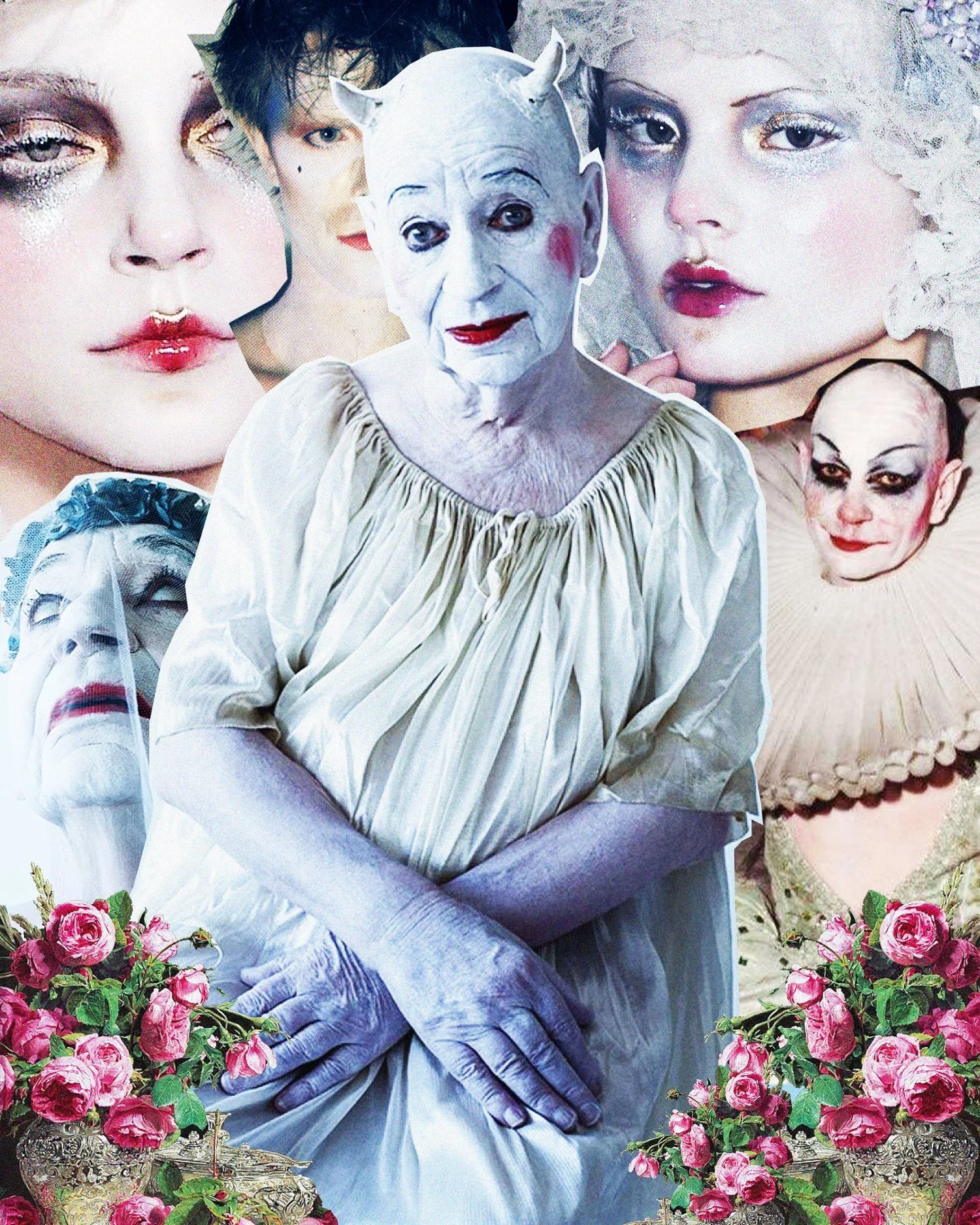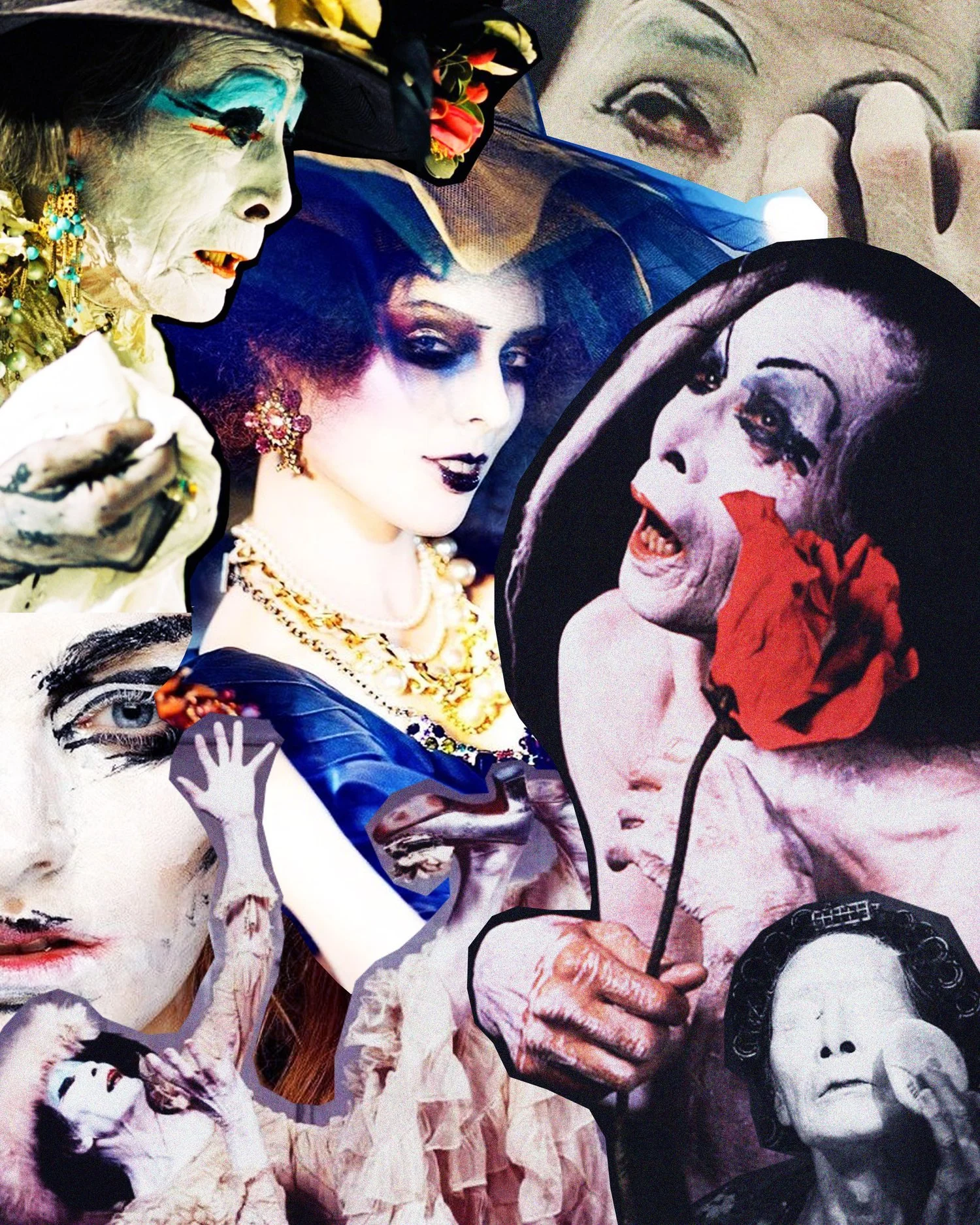Culture Slut: Full Face & Wearing Makeup Authentically
Make it stand out
“I’m tired of the traditional make up tropes of masking and concealment, instead we are focusing on illumination and highlighting.”
The newest entry into the celebrity beauty coliseum is none other than former One Direction boy-next-door turned ambiguously-queer-but-not-queer-maybe-who-knows superstar Harry Styles with his Pleasing ‘life brand’, and baby, I’m not having it. The history of celebrity endorsed beauty products is as old as celebrity itself, from Jean Harlow eye brow stencils to Elizabeth Taylor perfumes to youtuber eye shadow palettes, people have been moved by the faces that speak to them, for better or worse. the celebrity beauty industry goes through trends, just like everything else, like how ten-to-fifteen years ago everyone (and I mean everyone) had a perfume in their name (INCLUDING One Direction). There is something mysterious and enjoyable about a celebrity perfume I think, an ephemeral connection to your teenage idol, going to school smelling like Beyonce (rich and sensual), or Britney (sugary and fruity) , or The Cheeky Girls (vimto and teen discos), feeling like you’ve been anointed in true Diva Worship, truly transcendent over the mere mortals with their Impulse body sprays and floral Nivea roll-ons. But, alas, the world moves on and we are well into the age of celebrities opening their own beauty lines and ‘life brands’, whether we want them or not. Today, everyone and their mother have their own eye shadow palette (500 ways to sell 15 browns and a beige), and they’ve started the march on celebrity skin products, from Harry’s Pleasing Pen to Kylie Skin’s Hydrate and Glow, and it feels like there is everything still to play for.
For all his trying, Styles misses the mark and his comments play into a widespread and long held anti femme/anti queer assumption that heavy make up (and beyond this, all forms of artifice) is a form of hiding, and that people who wear little or no make up are somehow more ‘authentic’.
I would like to propose the opposite: the mask of make up is not something we hide behind, because it the very thing that can set us free. In short, Make up does not conceal, it reveals.
This celeb influence on beauty makes me reflect more on what I personally love about make up, what collaborations I would have buy without question if I was given the chance today. A blue glitter eye-shadow from Divine? Pupil-dilating eye drops from Greta Garbo? A range of black liners and pencils from Theda Bara? Fuchsia pink blush and three-hundred-layers-of-mascara from Quentin Crisp? Who are my personal make up icons? What is beauty? What is glamour? How do we decide who and what is beautiful, or tasteful, or too much? I look at these questions, the pictures I had (and still have) on my bedroom walls and I realise that there are two people who’s use of make up has inspired me to create, and really altered my initial perceptions of it as an art form: Lindsay Kemp and Kazuo Ohno. Both are icons of the stage, revolutionary performers and creators that lived full rewarding lives, both now live on not only through the documentation of their performances, but also in the make up and painted faces featured on high fashion runways, in classic magazines, and on the blogs of the keenest fashion historians.
___STEADY_PAYWALL___
Lindsay Kemp was a British dancer, mime artist, choreographer, actor, theatre grande dame, and supreme icon of queer performance. Born in 1938, he studied with expressionist dancer Hilde Holger and mime artist Marcel Marceau before mounting his own incredible stage productions in the 60s and 70s. His most famous work was an interpretation of Jean Genet’s Our Lady of the Flowers, which was so erotic, decadent and deviant that it garnered many hostile reviews in the supposedly free-loving London. I first saw him in the incredible sequences he produced for Derek Jarman’s seminal queer art house films Sebastiane and Jubilee. I thought he was absolutely electric, divine light emanating from his vile body, powerful and untouchable and lascivious and pure. His performance was otherworldly, and a lot of this was captured in his make up. Thick white paint and powder covered his face, with features drawn on over the top with quavering black lines, smeared rouge, shakily applied glitter, both DIY and completely transformative, it gave him the aspects of transcendence.
He is now perhaps most known for his impact on other stars, he was famously an early romance of David Bowie, and helped him create the look and performance of Ziggy Stardust, staging his concerts at the Rainbow Theatre with The Great Orlando, Jack Birkett. He was also a mentor to Kate Bush, teaching her expressive ways of movement and how to project narrative through performance. Kemp appears in Bush’s short film The Line, The Cross and The Curve. Kemp went on to make short cameos in cult films such Todd Hayne’s Velvet Goldmine and Robin Hardy’s The Wicker Man, but he remained active in the theatre for the rest of his life, constantly producing and starring in new shows that exhibited his fantastical beauty and tragic romance.
I love Kemp so much because he made things that I was scared of, like make up, accessible. As a young queer, I was very much moved by the perfect faces of Marlene Dietrich, Jean Harlow, Elizabeth Taylor, and then the more extreme Siouxie Sioux and Klaus Nomi, but I was always hesitant about making myself over like that, knowing that it required either the right kind of bones, or a lot of technical skill, time and products. Kemp’s face showed me that I could do whatever I wanted, and that if I just PUT IT ON then the fantasy was mine to make. It doesn't matter if an eyebrow shakes or lipstick is on your teeth, its part of the entire creation, the projection of self as a new and evolved being. I look fucking cool. I soon realised the same thing about dance and physical performance, so soon afterwards I took to the stage in a Snazaroo face and an ugly dress, and my world hasn’t been the same since.
“If I could create one celebrity collaboration make up product, it would be a Kemp x Kazuo Super White Face Powder, and I would wear it every time I needed to remember who the fuck I am.”
Kazuo Ohno was a Japanese dancer and writer who, alongside Tatsumi Hijikata, created a new style of dance called Butoh which rejected a lot of popular western dance principals in favour of it’s own, uniquely Japanese perspective. Ohno was born in 1906 and studied under the Japanese modern dance pioneers Baku Ishii and Takaya Eguchi in the 30s, before fighting in the second world war in China and New Guinea, and becoming a prisoner of war, held in a camp. Butoh was developed in the 50s and 60s and was inspired by post war Japan, the desolate landscape of the past and present, and the atrocities experienced by the Japanese people, and so often dealt with very introverted and taboo subjects. Ohno formed his own studio and performed for over fifty years after the war, and wrote several books on the art of Butoh.
I first saw Ohno on the cover of Anohni’s third album The Crying Light with Antony and The Johnsons, this strange, inhuman looking figure and I knew I had to find out more. Ohno had died in 2010 and was paid tribute to on the album cover and in the music video for The Spirit Was Gone, which was a collection of performance clips from Ohno’s vast catalogue. The movement is slow and deliberate, hyper controlled and very subtle an exercise in ‘resisting fixity’ and stagnation, but it was the look that really spoke to me. Butoh is often performed by dancers covered in white body paint in order to eliminate the personal identity of the dancer so that more focus can be given to the movement, but on top of this, Ohno was able to create the most incredible and beautiful characters.
Like Kemp, Ohno would draw on a haphazard face, an approximation of beauty and make up that may not have been very skilled in terms of application, but was totally and utterly transformative and unique. Ohno often played feminine characters and so would add this red slash of a mouth with lipstick, blue shadow smeared all over the eye lid and half way up his forehead, black liner slopped around the eye, and yet it remains some of the most beautiful and emotional make up to me. It is the combination of Ohno’s unique, super-aged face, this absolutely confident make up application, the beauty of his movement and story telling that cements Ohno in the realms of aspirational beauty for me, alongside Lindsay Kemp, Elizabeth Taylor, Divine, and all the rest.
Harry’s Pleasing press release includes the line “I’m tired of the traditional make up tropes of masking and concealment, instead we are focusing on illumination and highlighting,” and whilst it is just another way of trying to sell the same old slop, it has brought me to consider the power of ILLUMINATION WITHIN CONCEALMENT. Both Kemp and Ohno masked their faces with white so they could create without boundaries. But instead of the make up MASKING their identities, it HIGHLIGHTS them. The power of their own revolutionary selves were elevated by the images they projected and the visions their productions left in the minds of their audiences. The echoes of their faces can still be seen in the fashion images produced over the last 30 years, from Galliano to Dior to Westwood, Pat McGrath to Val Garland. Images of our queer fore-mothers and fore-fathers look back at us from bottomless pop culture pit, and we can smile when we recognise who they are and where they came from.
So, in answer to the question no one asked me, if I could create one celebrity collaboration make up product, it would be a Kemp x Kazuo Super White Face Powder, and I would wear it every time I needed to remember who the fuck I am.
Words and Images: Misha MN


